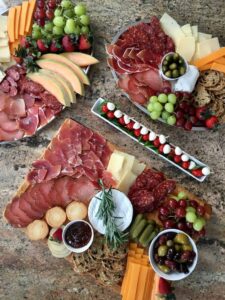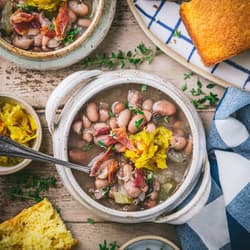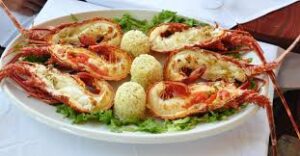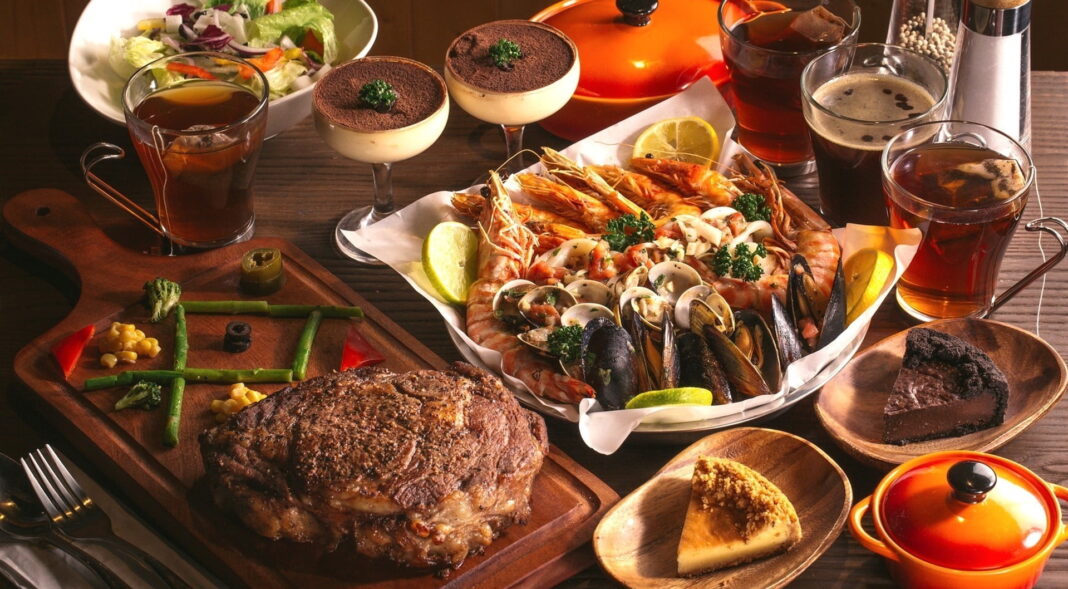Croatia:

Croatia, a small country on the Adriatic coast, generously rewards its guests not only with warmth, but also with treats. Local residents know how and love to eat well. They also know how to cook and treat. In order not to get confused when seeing unfamiliar names, Writualize offers you a virtual acquaintance with the local cuisine: then during a trip to Croatia you will easily navigate the menu and be able to order for your children what they like.
Specifics of Croatian cuisine:
 Despite the fact that Croatia cannot boast a large area, the cuisine of its regions cannot be called homogeneous. The central regions – Zagreb, Slavonia – gravitate towards the traditions of Austrian and Hungarian cuisine, to which Turkish notes are mixed.
Despite the fact that Croatia cannot boast a large area, the cuisine of its regions cannot be called homogeneous. The central regions – Zagreb, Slavonia – gravitate towards the traditions of Austrian and Hungarian cuisine, to which Turkish notes are mixed.
Here they love to eat hearty food, so meat predominates in the diet – beef, lamb, poultry.
The coast – Istria, Dalmatia, Kvarner, Dubrovnik – has all the characteristic features of Mediterranean cuisine. It is in the coastal towns that incredibly tasty fish and seafood dishes are prepared. Various vegetables are constantly on the tables. And the unique aroma of the dishes is given by herbs and spices – bay leaf, black and red pepper, basil, sage, rosemary, tarragon, oregano, parsley, garlic. At the same time, spices only shade the taste of the main product – the dishes are aromatic, but not spicy, and are quite suitable for children.
National dishes of Croatia:

Yes, Croatian cuisine really resembles the cuisine of other European countries and is influenced by Eastern culinary traditions. But there are special delicacies here that tourists are eager to try and buy as a souvenir.
Pršut – smoked or dried pork ham. In Dalmatia, prosciutto is smoked on coals, while in Istria it is dried in the open air. Before serving, prosciutto is cut into thin slices and served with sheep’s cheese, onions and olives, and sometimes with melon.
Not every cheese goes well with prosciutto. The Croats themselves consider Pag cheese (Paški sir), which is made from sheep’s milk and olive oil, to be the best addition. This traditional Croatian dish is prepared only on the island of Pag. The sheep on the island feed on aromatic herbs – sage, rosemary and others, which is why the cheese has a special smell. Kulen (kulin) is very popular in Croatia. It is a smoked pork sausage, generously seasoned with red pepper and garlic. The dish is very popular in Slavonia, but is also considered a delicacy here: kulen is served on major holidays. Moreover, there is a holiday dedicated to the sausage itself – the Kulenjada festival.
Where to start a meal:

Despite all the love the Croatians have for vegetable dishes, they do not have a cult of salads. Often, restaurants simply serve an assortment of coarsely chopped vegetables, lettuce leaves or shredded cabbage, they can be seasoned with oil, salt, and spices on the tables.
It is interesting that, in addition to olive oil, here you can also be offered other vegetable oils – corn, pumpkin.
But seafood salads are very common. On the menu, such a dish may be listed under the name mješana riblja salata – an assortment of fish, shellfish, and crustaceans.
First courses:

Soup – an irreplaceable and important dish in the diet of children – can already be a hearty meal, after which you will not need a second course.
- Maneštra is a thick soup with corn, beans, cabbage, small pasta and smoked meat.
- Čorba is a typical dish for Croatia and other Balkan countries.
Hot tomato soup with rice is also very common in the country. But if your child does not like thick soups, order chicken or beef broth with dumplings, homemade noodles or rice, they are on the menu of any restaurant.
In hot weather, everyone will be happy with a cold cucumber and cream soup, seasoned with garlic and red pepper. If you are on holiday in Croatia with a small child, you can order a regular vegetable soup without any seasonings (Juha od povrća) in a restaurant.
Meat dishes:

Croats have a special passion for meat dishes. You can always order something traditional, but Croatian culinary masterpieces made from meat deserve special attention, and each region has its own signature dish. What to try from Croatian cuisine if you share the locals’ love for meat?
- Visovačka begavica is the calling card of the city of Šibenik (a resort in Northern Dalmatia). This melt-in-your-mouth dish is made from lamb cooked in sour milk.
- Pržolica is a hearty dish for which beef tenderloin is first fried and then stewed with bacon and spices. The best pržolica is prepared in Međimurje.
- Pisana pečenica Stubica is the name of the aromatic pork fillet stuffed with prunes. This is the signature dish of Zagorje.
- Čobanac is a traditional dish from Slavonia that combines two types of meat and herbs.
- Sarma – Croatian cabbage rolls made from sauerkraut with prosciutto added to the mince.
- Dalmatian Pašticada – beef stewed in wine sauce and served with gnocchi.
- Posavina and Tkrpolje are famous for their poultry dishes, while Gorski Kotar is unrivaled in its game preparation.
Want to find something familiar on the menu? Look for punjenje paprike – bell peppers stuffed with meat and rice.
Fish and seafood:

Fish is also cooked superbly in Croatia – the Adriatic Sea brings a rich catch, and the country’s rivers are rich in fish. When studying the menu, pay attention to whether the fish is served fried (na žaru), baked (u pećnici) or boiled (lešo). The most common fish in the country are sea bass (brancin), dorado (orada), mullet (cipal), red sea bass (škrpina). Seafood also takes pride of place on the menu. Oysters are served as a separate dish, mussels, shrimp, scallops and octopuses are used to prepare salads and hot dishes. Culinary delights using octopuses may interest your child if you tell him that octopus in Croatian is hobotnica. A special dish with seafood is crni rižot. This is rice seasoned with cuttlefish ink. The color of the dish is black, hence the name, and the taste is extraordinary.
If black rice seems too exotic, choose regular rice with mussels. You can also try brodeto (brodet) in Croatia. This is a stew of fish and seafood pieces with vegetables. Brodet is generously seasoned with hot spices, and wine is added when stewing. Slavonia has excellent carp paprikash in its arsenal of fish dishes.
Side dishes:

Side dishes should be mentioned separately. Vegetables are served with meat and fish – potatoes, tomatoes, cabbage, artichokes, asparagus, as well as porridge – rice, corn.
Pasta is also very popular in Croatia, there are many varieties of pasta: fuži, pljukanci, šurlice and others. Look for the name “mlince” on the menu – this is a pasta dish, not pancakes. They are baked in the oven, then cut into squares and served with meat dishes.
Pasta with truffles turns from a side dish into an independent gourmet dish. Stewed Swiss chard is also very popular as a side dish. In Croatia it is called blitva.
Original desserts:

Croats also know a lot about sweets. While vacationing at one of the Croatian resorts, you can arrange a real tasting of delicious and even healthy desserts, for the preparation of which berries, fruits, nuts and honey are generously used. Often, fruits are simply served candied – simple and very tasty. And here is a short list of sweet pastries:
- Rab cake (Rapska torta) is a unique dessert that can only be tried in Croatian restaurants. It is believed that its recipe was invented on the island of Rab and has since been kept secret. So you can try this sweet or bring it home as a delicious gift, but you cannot bake it yourself, alas.
- Stonska torta is not a cake at all, but a casserole made of large pasta tubes filled with sweet cottage cheese, sometimes nuts and chocolate.
- Bucnica is a traditional pie with cottage cheese and pumpkin.
- Povitica is a sweet roll made of yeast dough with a nut filling.
- Zagorski štrukli are a kind of puff pastry pies with a cottage cheese filling, which are first boiled, then fried and topped with cream.
- Međimurska gibanica is a layered pie with a filling of cottage cheese, poppy seeds, nuts and apples. A similar dessert is prepared in Slovenia.
These desserts are eaten sitting at the table. And how many small pastries there are in Croatian cuisine! Here they love almond cookies, fig cookies, chestnut sweets. And what delicious names these sweets have:
- Fritulas and krostulas are deep-fried sweet dough. In our country, fritulas are known as “brushwood”, and krostulas are narrow strips of dough tied in a knot. Children will definitely not be satisfied with this crispy delicacy.
- Rafioli – almond-filled pastries.
- Tsukarina – tiny pastries with sugar sprinkles.
- Dalmatinska rožata – caramel pudding.
- Paprenjak – cookies with spices, black pepper and chopped nuts. Unlike spiced cookies, which are cut out with molds in other countries, Croatians make paprenjak with special three-dimensional stamps.
Each cafe prepares its own desserts, and it is difficult not to be tempted by them. It may happen that the cafe owner will treat you to fruit marmalade that she has made herself.
Drinks:

The choice of soft drinks in Croatian cafes and restaurants is traditional: tea, coffee, mineral water. But there are some nuances. For example, if you order tea, you will be brought a herbal drink. To have black tea brought to you, ask for indijski čaj. Coffee in Croatia is a quality and very common drink. It is preferred for breakfast and is drunk throughout the day. For children, you can order coffee with milk (kava sa mljekom), with cream (kava sa šlagom) or with whipped cream (bjela kava). A glass of cold water is served with a regular espresso.
In hot weather, cafes and restaurants offer visitors fresh lemonade. The soft drink is prepared without sugar: you can sweeten it to your taste.
Tips for children:

The national cuisine of Croatia is hearty, simple and healthy. Most traditional dishes are suitable for a child who eats from the adult table. The only exceptions are, perhaps, dishes that are prepared with the addition of wine: pašticada or brodet. Spicy dishes such as brodet or kulen sausage are also not suitable for children. You should be careful when offering prosciutto to a child. If you are wary of smoked meat, do not order maneshtra soup for your child. If there is nothing suitable for your child on the menu, ask for a simple dish: boiled meat or fish without spices, clear broth, porridge with milk or water, mashed potatoes. The hosts, as a rule, try to help all their guests.
Where to try:

You can taste Croatian dishes in expensive restaurants. But to really enjoy the food, it is better to dine in small family restaurants. If the sign says gostionica, gostiona, konoba, then you will find home comfort and delicious food inside. At the same time, try to choose a restaurant far from the tourist area and favored by locals. Usually, in such places, prices are lower, and each guest is treated with care by the hosts. The treats in family restaurants are usually very plentiful. A portion of salad, meat or fish dish can easily be shared between two. If you are not looking for a big lunch but a light snack, opt for a café (kavana, kafić). Many of them open very early so that people can have breakfast before work or before going to the sea. The best selection of Croatian desserts is in pastry shops (slasticarnica, slasticarna). Often tables are set up inside so that visitors can try tori, cakes and ice cream right on the spot.
Sometimes fast food establishments, of course, also Croatian, come in very handy. The most popular dish here is čevapčići sausages or pljeskavica cutlet in a flatbread. Italian restaurants and pizzerias are also common in Croatia. Wherever you are going to have breakfast, lunch or dinner, start your meal with the words “Dobar tek!”, which means “Bon appetit” in Croatian. And while you eat, you can discuss your future plans. To decide how to spend your time, check out the Writualize Activities collection – there is much to see and do in Croatia.
